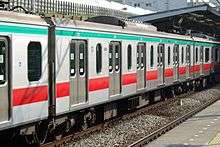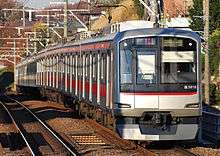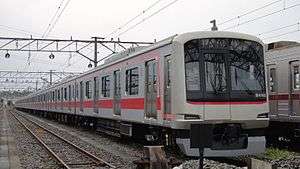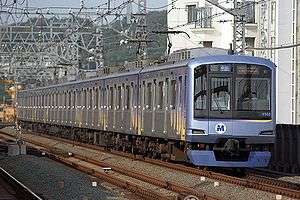Tokyu 5000 series
The Tokyu 5000 series (東急5000系 Tōkyū 5000-kei) is an electric multiple unit (EMU) train type operated by the private railway operator Tokyu Corporation since 2002 on many of its commuter lines in the Tokyo area of Japan.
Design
First introduced in 2002, the design is based on the JR East E231 series commuter train, also manufactured by Tokyu Car Corporation (now J-TREC) in Yokohama.
All trains are equipped with interior LCD screens, displaying the station names, and automatic announcements in both Japanese and English. The 5000 series uses blue seat moquette fabric, while the 5050 and 5080 series have red seat moquette.
Driver's cab
All sets use the same driver's cab, with a gray color, and a single 'T' shaped brake and throttle controller. There are four throttle steps, and seven brake steps. The speedometers are equipped with ATC. To the right of the speedometer is an information screen, showing the run type (local, express, etc.), and information of the individual cars. This touch screen computer can also control interior temperature and lights.
Variants
- 5000 series: 10-car sets used on the Tokyu Den-en-toshi Line since May 2002
- 5050 series: 8-car sets used on the Tokyu Toyoko Line
- 5050-4000 series: 10-car sets used on Tokyu Toyoko Line inter-running services since September 2012
- 5080 series: 6-car sets used on the Tokyu Meguro Line since March 2003
- Y500 series: 8-car sets used on Minatomirai Line/Tokyu Toyoko Line inter-running services since February 2004
5000 series
| Tokyu 5000 series | |
|---|---|
|
A Den-en-toshi Line 5000 series set in August 2007 | |
| In service | 2002–Present |
| Manufacturer | Tokyu Car Corporation, J-TREC |
| Built at | Yokohama |
| Constructed | 2002– |
| Number in service | 22 sets (212 vehicles, as of 1 April 2015)[1] |
| Formation | 8/10 cars per trainset |
| Fleet numbers | 5101-5122 |
| Operator(s) | Tokyu Corporation |
| Depot(s) |
|
| Line(s) served | |
| Specifications | |
| Car body construction | Stainless steel |
| Car length | 20 m (65 ft 7 in) |
| Doors | 4 pairs per side |
| Maximum speed | 110 km/h (70 mph) |
| Traction system | IGBT-VVVF inverter |
| Power output | 190 kW per motor |
| Acceleration | 3.3 km/h/s |
| Deceleration | 3.5 km/h/s (4.5 km/h/s for emergency brake) |
| Electric system(s) | 1,500 V DC |
| Current collection method | overhead |
| Bogies | TS-1019A/TS-1020A |
| Braking system(s) | Regenerative brakes, electronically controlled pneumatic brakes |
| Safety system(s) | TASC, ATC |
| Track gauge | 1,067 mm (3 ft 6 in) |

These are 10-car sets first introduced on the Den-en-toshi Line from May 2002. These sets are distinguished by a green stripe above the doors. 6-door cars were inserted into some of the sets between 2005 and 2007, with sets 5105 onward having three 6-door cars per set (cars 4, 5, and 8). The 5000 series is fitted with CS-ATC and Tobu ATS (TSP) in order to run through the Tokyo Metro Hanzomon Line, and onward over the Tobu Skytree Line to Tōbu-Dōbutsu-Kōen, Tobu Isesaki Line to Kuki, and Tobu Nikko Line to Minami-Kurihashi. These sets are based at Tokyu's Nagatsuta depot, and are powered by Hitachi motors with VVVF inverters.
Four 5000 series sets (5118, 5119, 5121, and 5122)[1] were formed from 2009 using trailer cars displaced from 10-car sets by newly built six-door cars. These sets have the same pink stripe above the doors as the Toyoko Line 5050 series sets.
New four-door cars were built from December 2015[2] to replace the three six-door cars in each set to ensure uniform door-spacing ahead of the introduction of platform edge doors at Den-en-toshi Line stations from 2016. All six-door cars are scheduled to be replaced by the end of fiscal 2017. The new cars added incorporate a number of interior design improvements, including higher seat backs and headrests on some seats.[3]
Operations
Formations
The sets are formed as follows.[1]
Den-en-toshi Line set 5101
| Car No. | 1 | 2 | 3 | 4 | 5 | 6 | 7 | 8 | 9 | 10 |
|---|---|---|---|---|---|---|---|---|---|---|
| Designation | Tc2 | M | T3 | M2 | M1 | T2 | T1 | M2 | M1 | Tc1 |
| Numbering | 5101 | 5201 | 5301 | 5401 | 5501 | 5601 | 5701 | 5801 | 5901 | 5001 |
The M1 cars (5 and 9) are each fitted with two single-arm pantographs, and the M car (2) is fitted with one pantograph.[1]
Den-en-toshi Line sets 5102 onward
| Car No. | 1 | 2 | 3 | 4 | 5 | 6 | 7 | 8 | 9 | 10 |
|---|---|---|---|---|---|---|---|---|---|---|
| Designation | Tc2 | M2 | M1' | T3N | T2N | M2 | M1 | T1N | M | Tc1 |
| Numbering | 5100 | 5200 | 5300 | 5400 | 5500 | 5600 | 5700 | 5800 | 5900 | 5000 |
The M1 cars (3 and 7) are each fitted with two single-arm pantographs, and the M car (9) is fitted with one pantograph.[1]
Toyoko Line 8-car sets

| Car No. | 1 | 2 | 3 | 4 | 5 | 6 | 7 | 8 |
|---|---|---|---|---|---|---|---|---|
| Designation | Tc2 | M2 | M1 | T2 | T1 | M2 | M1 | Tc1 |
| Numbering | 5100 | 5200 | 5300 | 5400 | 5500 | 5600 | 5700 | 5800 |
The M1 cars (3 and 7) are each fitted with two single-arm pantographs.[1]
Interior
-

5000 series interior
-

5000 series 6-door car interior
-

Passenger information screen
5050 series
| 5050 series | |
|---|---|
|
Toyoko Line 5050 series, July 2005 | |
| In service | April 2004– |
| Manufacturer | Tokyu Car Corporation |
| Built at | Yokohama |
| Number in service | 26 sets (208 vehicles, as of 1 April 2015)[1] |
| Formation | 8 cars per set |
| Fleet numbers | 5151–5176 |
| Operator(s) | Tokyu Corporation |
| Depot(s) | Motosumiyoshi |
| Line(s) served | ■ Tokyu Toyoko Line |
| Specifications | |
| Car body construction | Stainless steel |
| Car length | 20,200 mm (end cars); 20,000 mm (intermediate cars) |
| Width | 2,820 mm |
| Height | 4,050 mm |
| Doors | 4 pairs per side |
| Maximum speed | 110 km/h (70 mph) |
| Electric system(s) | 1,500 V DC |
| Current collection method | Overhead line |
| Track gauge | 1,067 mm (3 ft 6 in) |
Eighteen eight-car sets were introduced on the Toyoko Line from April 2004. These sets are distinguished by a pink stripe above the doors. These are similar to the 5000 series, the only difference being that they have eight cars, and that they have the pink stripe instead of green. They are based at Motosumiyoshi Depot, and are capable of running through the Minatomirai Line.
Operations
Formation
Toyoko Line eight-car sets are formed as follows.[1]
| Car No. | 1 | 2 | 3 | 4 | 5 | 6 | 7 | 8 |
|---|---|---|---|---|---|---|---|---|
| Designation | Tc2 | M2 | M1 | T2 | T1 | M2 | M1 | Tc1 |
| Numbering | 5150 | 5250 | 5350 | 5450 | 5550 | 5650 | 5750 | 5850 |
The M1 cars (3 and 7) are each fitted with two single-arm pantographs.[1]
Interior
-

5050 series interior
5050-4000 series
| 5050-4000 series | |
|---|---|
|
Set 4102 at Shinrinkoen Depot on the Tobu Tojo Line in August 2011 | |
| In service | September 2011– |
| Manufacturer | Tokyu Car Corporation (4101-4107), J-TREC (4108-4110) |
| Built at | Yokohama |
| Constructed | 2011– |
| Number in service | 100 vehicles (10 sets) |
| Formation | 10 cars per set |
| Fleet numbers | 4101–4110 |
| Operator(s) | Tokyu Corporation |
| Depot(s) | Motosumiyoshi Depot |
| Line(s) served | |
| Specifications | |
| Car body construction | Stainless steel |
| Car length |
20,200 mm (66 ft 3 in) (end cars) 20,000 mm (65 ft 7 in) (intermediate cars) |
| Width | 2,820 mm (9 ft 3 in) |
| Height | 4,050 mm (13 ft 3 in) |
| Doors | 4 pairs per side |
| Maximum speed | 120 km/h (75 mph) |
| Power output | 190 kW x 4 per motored car |
| Acceleration | 3.3 km/h/s |
| Deceleration | 3.5 km/h/s (service); 4.5 km/h/s (emergency) |
| Electric system(s) | 1,500 V DC |
| Current collection method | Overhead line |
| Bogies | TS-1019A (motored); TS-1020A (trailer) |
| Safety system(s) | ATC-P/S, Tobu ATS, Seibu ATS |
| Track gauge | 1,067 mm (3 ft 6 in) |
New 5050-4000 series 10-car sets based on the 5050 series design were delivered from Tokyu Car from April 2011, entering service from September 2012 ahead of the start of Tokyu Toyoko Line and Tokyo Metro Fukutoshin Line inter-running services in March 2013.[4] These are often referred to simply as "4000 series".[5]
Operations
- ■ Tokyu Toyoko Line
- ■ Minatomirai Line
- ■ Tokyo Metro Fukutoshin Line (since 10 September 2012)
- ■ Seibu Ikebukuro Line (since 10 September 2012)
- ■ Tobu Tojo Line (since 10 September 2012)
Formations
The 10-car sets are formed as follows.[6]
| Car No. | 1 | 2 | 3 | 4 | 5 | 6 | 7 | 8 | 9 | 10 |
|---|---|---|---|---|---|---|---|---|---|---|
| Designation | Tc2 | M2' | M1 | T3 | T2 | M | T1 | M2 | M1' | Tc1 |
| Numbering | 4100 | 4200 | 4300 | 4400 | 4500 | 4600 | 4700 | 4800 | 4900 | 4000 |
| Weight (t) | 27.8 | 32.7 | 33.6 | 26.3 | 26.1 | 33.5 | 26.5 | 32.7 | 33.5 | 27.6 |
| Capacity (Seated/total) | 48/141 | 51/151 | 54/152 | 54/152 | 54/152 | 54/152 | 54/152 | 54/152 | 51/151 | 48/141 |
The M1 and M1' cars each have two single-arm pantographs, and the M car is fitted with one.[6]
Cars 4601 to 4604 (included in sets 4101 to 4104 respectively) were renumbered from former Denentoshi Line 5000 series cars 5469, 5473, 5474, and 5472 (from sets 5169, 5173, 5174, and 5172 respectively), and retain their original blue moquette seating.[7]
Interior
-
Interior view of car 4008, July 2013
-
7-person bench seating, July 2013
-
Priority seating in car 4008, July 2013
-
Wheelchair space in car 4908
-
The interior of car 4601 (formerly 5000 series car 5918) with original blue seating moquette
-

LCD passenger information screens above the doorways, December 2011
Shibuya Hikarie

Set number 4110 was delivered in April 2013 in a special Shibuya Hikarie body graphics and with modified interior to mark the first anniversary of Tokyu's "Shibuya Hikarie" development located above the newly expanded underground Shibuya Station.[8] This trainset entered revenue service on 26 April 2013.[9] It is the first 5050 series train to feature LED interior lighting, and has higher backed seating than regular trains, with grey seat backs in cars 1, 3, 8, and 10, brown seat backs in cars 2, 4, 6, and 9, and blue seat backs in cars 5 and 7.[10] The train is equipped experimentally with free WiFi.[10] One stanchion in the train features an embossed heart design as a whimsical way to brighten up commuters' journeys.[10]
-
Interior of car 4110 (car 1)
-

Interior of car 4410 (car 4)
-

Interior of car 4510 (car 5)
-
Seating in car 4110 with grey seat backs
-
Priority seating in car 4110
-
The embossed heart design on one of the trains stanchions
History
Nine cars of the first set were delivered from Tokyu Car's Yokohama factory to Tokyu's Nagatsuta Depot in Kanagawa Prefecture between 29 and 31 March 2011.[5][11] These cars were formed into a 10-car set with the inclusion of intermediate motor car 4601, renumbered from former 5050 series trailer car 5469, which was itself previously renumbered from motor car 5918.[12] The second 10-car set was delivered from Tokyu Car in June 2011.[13]
Set 4101 entered revenue service on the Tokyu Toyoko Line from 9 September 2011, reduced to an 8-car formation.[14]
From 10 September 2012, 10-car 5050-4000 series sets entered revenue service on the Seibu Ikebukuro Line (and Seibu Yurakucho Line) and Tobu Tojo Line, with inter-running through to the Tokyo Metro Fukutoshin Line and Tokyo Metro Yurakucho Line.[15][16]
5080 series
| 5080 series | |
|---|---|
|
Meguro Line 5080 series, September 2005 | |
| In service | March 2003– |
| Manufacturer | Tokyu Car Corporation |
| Built at | Yokohama |
| Number in service | 60 vehicles (10 sets) |
| Formation | 6 cars per set |
| Fleet numbers | 5181-5190 |
| Operator(s) | Tokyu Corporation |
| Depot(s) | Motosumiyoshi |
| Line(s) served | ■ Tokyu Meguro Line |
| Specifications | |
| Car body construction | Stainless steel |
| Car length |
20,200 mm (66 ft 3 in) (end cars) 20,000 mm (65 ft 7 in) (intermediate cars) |
| Width | 2,820 mm (9 ft 3 in) |
| Height | 4,050 mm (13 ft 3 in) |
| Doors | 4 pairs per side |
| Maximum speed | 90 km/h (55 mph) |
| Acceleration | 3.3 km/h/s |
| Deceleration | 3.5 km/h/s (service), 4.5 km/h/s (emergency) |
| Electric system(s) | 1,500 V DC |
| Current collection method | Overhead line |
| Bogies |
TS-1019A (motored) TS-1020A (trailer) |
| Track gauge | 1,067 mm (3 ft 6 in) |
Ten six-car sets were introduced on the Meguro Line from March 2003. These sets are distinguished by a dark blue stripe above the doors. Unlike the other variants, they are powered by Toshiba equipment, rather than Hitachi. The 5080 series is fitted with CS-ATC, ATO and TASC for use on the Tokyo Metro Namboku Line, Saitama Rapid Railway Line, and Toei Mita Line. These sets are based at Motosumiyoshi Depot.
Operations
Formation
Meguro Line six-car sets are formed as follows, with three motored (M) cars and three trailer (T) cars. Car 1 is at the Meguro end.[1][17]
| Car No. | 1 | 2 | 3 | 4 | 5 | 6 |
|---|---|---|---|---|---|---|
| Designation | Tc2 | M | T | M2 | M1 | Tc1 |
| Numbering | 5180 | 5280 | 5380 | 5480 | 5580 | 5680 |
| Weight (t) | 26.3 | 30.9 | 28.2 | 33.3 | 32.9 | 26.4 |
| Capacity (total/seated) | 141/48 | 152/51 | 151/54 | 151/54 | 152/51 | 141/48 |
The M1 cars (5) are fitted with two single-arm pantographs, and the M cars (2) are fitted with one.[17]
Interior
-

5080 series interior
-

Priority seating
-

LED passenger information display in car 5181
-

LCD passenger information display in car 5185
Y500 series
| Y500 series | |
|---|---|
|
Yokohama Minatomirai Railway Y500 series on Tokyu Tōyoko Line, September 2005 | |
| In service | February 2004– |
| Manufacturer | Tokyu Car Corporation |
| Built at | Yokohama |
| Constructed | 2004– |
| Number in service | 6 sets (48 vehicles) |
| Formation | 8 cars per set |
| Fleet numbers | Y511-Y516 |
| Operator(s) | Yokohama Minatomirai Railway |
| Line(s) served | |
| Specifications | |
| Car body construction | Stainless steel |
| Car length | 20,200 mm (end cars); 20,000 mm (intermediate cars) |
| Width | 2,820 mm |
| Height | 4,050 mm |
| Doors | 4 pairs per side |
| Maximum speed | 110 km/h (70 mph) |
| Electric system(s) | 1,500 V DC |
| Current collection method | Overhead line |
| Track gauge | 1,067 mm (3 ft 6 in) |
These eight-car sets are owned by the Yokohama Minatomirai Railway and are used for interrunning services over the Tokyu Toyoko Line and Minatomirai Line. The fleet of six eight-car sets entered service in February 2004.
Operations
- ■ Minatomirai Line
- ■ Tokyu Toyoko Line
- ■ Tokyo Metro Fukutoshin Line (since 16 March 2013)
- ■ Seibu Ikebukuro Line (since 16 March 2013)
- ■ Tobu Tojo Line (since 16 March 2013)
Formation
Yokohama Minatomirai Railway Y500 series sets are formed as follows.[1]
| Car No. | 1 | 2 | 3 | 4 | 5 | 6 | 7 | 8 |
|---|---|---|---|---|---|---|---|---|
| Designation | Tc2 | M2' | M1 | T2 | T1 | M2 | M1' | Tc1 |
| Numbering | Y510 | Y540 | Y550 | Y560 | Y570 | Y580 | Y590 | Y500 |
The M1 cars (3 and 7) are each fitted with two single-arm pantographs.[1]
Interior
-

Y500 series interior
References
- 1 2 3 4 5 6 7 8 9 10 11 12 私鉄車両編成表 2015 [Private Railway Rolling Stock Formations - 2015] (in Japanese). Japan: Kotsu Shimbunsha. 23 July 2015. pp. 62–65, 78. ISBN 978-4-330-58415-7.
- ↑ 東急5000系6扉車置換え用の4扉車が甲種輸送される [Tokyu 5000 series replacement 4-door cars delivered]. Japan Railfan Magazine Online (in Japanese). Japan: Koyusha Co., Ltd. 24 December 2015. Retrieved 24 December 2015.
- ↑ 東京急行電鉄5000系6ドア車置換え車 [Tokyu 5000 series 6-door car replacement cars]. Japan Railfan Magazine (in Japanese). Vol. 56 no. 659. Japan: Koyusha Co., Ltd. March 2016. p. 71.
- ↑ 2011年度の鉄軌道事業設備投資計画は総額367億円 [Total railway business investment of 36.7 billion yen for fiscal 2011] (pdf). Tokyu news release (in Japanese). Japan: Tokyu Corporation. 13 May 2011. Retrieved 17 May 2011.
- 1 2 東急4000系・5050系が甲種輸送される [Tokyu 4000 and 5050 series delivered]. Japan Railfan Magazine Online (in Japanese). Japan: Koyusha Co., Ltd. 30 March 2011. Retrieved 30 March 2011.
- 1 2 "東急5050系4000番台" [Tokyu 5050-4000 series]. Japan Railfan Magazine. Vol. 51 no. 603. Japan: Koyusha Co., Ltd. July 2011. p. 90.
- ↑ Shibata, Togo (March 2016). 5000系シリーズのバリエーション [Variations in the 5000 series]. Tetsudō Daiya Jōhō Magazine (in Japanese). Vol. 45 no. 383. Japan: Kōtsū Shimbun. p. 46.
- ↑ "特別仕様列車「Shibuya Hikarie号」詳細" [Details of special "Shibuya Hikarie" train] (PDF). Tokyu Corporation. Retrieved 8 April 2013.
- ↑ "「Shibuya Hikarie号」がデビュー" ["Shibuya Hikarie" debut]. Japan Railfan Magazine Online (in Japanese). Japan: Koyusha Co., Ltd. 27 April 2013. Retrieved 3 May 2013.
- 1 2 3 "「Shibuya Hikarie号」" [Shibuya Hikarie]. Japan Railfan Magazine (in Japanese). Vol. 53 no. 626. Japan: Koyusha Co., Ltd. June 2013. p. 59.
- ↑ "甲種鉄道車両輸送計画表" [New Rolling Stock Delivery Schedule]. Tetsudō Daiya Jōhō Magazine. Vol. 40 no. 324. Japan: Kōtsū Shimbun. April 2011. p. 123.
- ↑ 東急4000系が田園都市線内で試運転 [Tokyu 4000 series test run on Den-en-toshi Line]. Japan Railfan Magazine Online (in Japanese). Japan: Koyusha Co., Ltd. 26 April 2011. Retrieved 26 April 2011.
- ↑ "甲種鉄道車両輸送計画表" [New Rolling Stock Delivery Schedule]. Tetsudō Daiya Jōhō Magazine. Vol. 40 no. 326. Japan: Kōtsū Shimbun. June 2011. p. 127.
- ↑ 東急5050系4000番台が営業運転を開始 [Tokyu 5050-4000 series enters revenue service]. Japan Railfan Magazine Online (in Japanese). Japan: Koyusha Co., Ltd. 10 September 2011. Retrieved 10 September 2011.
- ↑ 東急5050系が西武鉄道池袋線で営業運転開始 [Tokyu 5050 series enters service on the Seibu Ikebukuro Line]. RM News (in Japanese). Japan: Neko Publishing. 10 September 2012. Retrieved 10 September 2012.
- ↑ 東急5050系4000番台が東武東上線・地下鉄有楽町線で営業運転開始 [Tokyu 5050-4000 series enters service on the Tobu Tojo Line and Tokyo Metro Yurakucho Line]. Japan Railfan Magazine Online (in Japanese). Japan: Koyusha Co., Ltd. 11 September 2012. Retrieved 11 September 2012.
- 1 2 東急電鉄 目黒線用5080系 [Tokyu Meguro Line 5080 series]. Japan Railfan Magazine (in Japanese). Vol. 43 no. 503. Japan: Koyusha Co., Ltd. March 2003. p. 82.
External links
| Wikimedia Commons has media related to Tokyu 5000 series. |
- Tokyu EMU details (Japanese)
- Tokyu 5000 series (Japan Railfan Magazine Online) (Japanese)
- Tokyu 5050 series (Japan Railfan Magazine Online) (Japanese)
- Tokyu 5080 series (Japan Railfan Magazine Online) (Japanese)
- Minato Mirai Y500 series (Japan Railfan Magazine Online) (Japanese)




